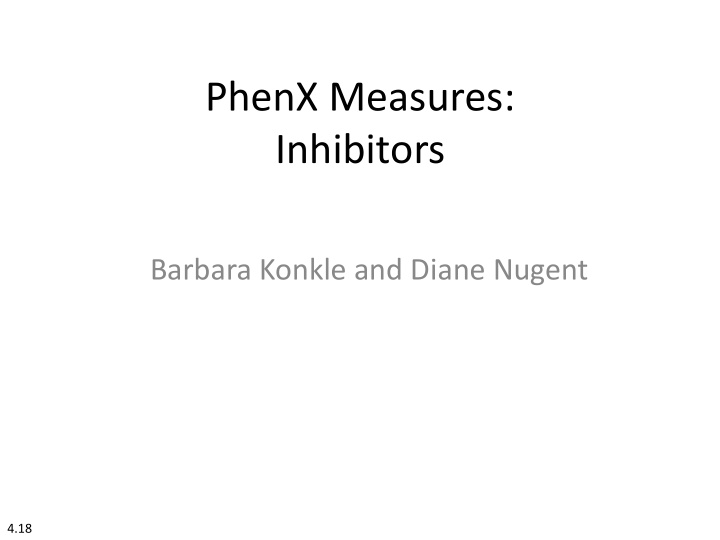



PhenX Measures: Inhibitors Barbara Konkle and Diane Nugent 4.18
Inhibitors • Assays • Existing Inhibitor State • Evolving Inhibitor State • Resolving or Persistent Inhibitor State
Laboratory Measures of Inhibitor Impact • Factor VIII activity in plasma – One-stage assay – Chromogenic assay • Quantitative measure of inhibitor activity – Nijmegen modification of Bethesda assay • Measure of response to factor infusion – PK study to assess initial factor recovery and half-life
FVIII Activity • Definition: A bioassay to determine factor VIII activity in plasma. • Purpose: Factor VIII (FVIII) activity measured in plasma determines the severity of hemophilia A. Values that are less than anticipated may reflect the presence of a neutralizing antibody (inhibitor).
Plasma FVIII Activity • One-stage FVIII activity assay in plasma 1,2 – Validated and widely available in clinical labs – Results can vary by reagent/instrument used • Particularly for modified recombinant FVIII products • Does not correlate with bleeding risk in setting of emicizumab • Chromogenic FVIII activity in plasma 1,2 – Less widely available in clinical labs – Generally, more uniform measures across laboratories 1 – Chromogenic assay using bovine reagents not influenced by emicizumab 1 Kitchen, et al. Haemophilia 2016;22(Suppl 5):72-77. 2 Peyvandi, Oldenburg and Friedman. J Thromb Haemost. 2016;14:248-61.
Questions • Do we state that FVIII should be measured by chromogenic assay centrally? – Would limit use of data collected locally • Do we state that either can be used but caveats noted?
Pre-analytical variables in FVIII measurement • Blood collected by direct venipuncture into 3.2% NaCitrate tube and filled correctly 1 – Should be second tube collected. If no other tube drawn, a discard tube should be obtained. Blood should fill tube to within 33% of fill line. (11% if aPTT measured) • Sample should be kept at RT and platelet poor plasma prepared within 4 hours of collection. 2 – Centrifuge should be validated so that process results in < 10,000 platelets/microliter – Can be stored at -20 o C for 2 weeks, and should be transfered to <-70 o C for longer storage, including shipment. 1 Lippi et al, Quality standards for sample collection in coagulation testing. Semin Thromb Hemost 2012;38:565-75. 2 Funk et al, Quality standards for sample processing, transportation, and storage in hemostasis testing. Semin Thromb Hemost 2012;38:576-85.
Bethesda Assay for Inhibitor Quantification • Described in 1975 to quantify FVIII inhibitory activity. 1 • Modified “Nijmegen modification,” to provide the same buffering in patient sample and control and eliminate low titer false positives. 2 • Further modified and validated to include a step to heat and thus inactivate factor so that assay can be performed in patients on regular factor infusions. 3 • Low titer: < 5 B.U.; high titer: > 5 B.U. 4 1 Kasper CK, et al. Thromb Diath Haemorrh 1975; 34 (3) 869-872 2 Verbruggen B, et al. The Nijmegen modification of the Bethesda assay for factor VIII:C inhibitors: improved specificity and reliability. Thromb Haemost 1995;73:247-51 3 Miller CH, et al. Validation of Nijmegen-Bethesda assay modifications to allow inhibitor measurement during replacement therapy and facilitate inhibitor surveillance. J Thromb Haemost 2012;10:1055-61. 4 Blanchette VS, Key NS, Ljung LR, Manco-Johnson MJ, ven den Berg HM, Srivastava A. For the Subcommittee on factor VIII, factor IX and rare coagulation disorders: Definitions in hemophilia: communication from the SSC of the ISTH. J Thromb Haemost 2014; 12: 1935-1939
PK Study to Assess Response to Factor Infusion • Definition: A series of plasma factor VIII (FVIII) activity determinations in blood samples obtained immediately prior to, and at time points after, infusion of FVIII concentrate. • Purpose: A pharmacokinetic (PK) study is used to determine the initial recovery and half-life of infused FVIII concentrate. International ITI study used before infusion and 15-30 minutes, and 1, 2, 4, 6, 24, and 48 hours after infusion.
Existing Inhibitor State • Inhibitor Diagnosis – Clinical: Lack of response (cessation of bleeding) to factor infusion for treatment of bleeding – Laboratory: Less than expected FVIII level and/or positive inhibitor titer in routine surveillance.
Evolving Inhibitor State • Change in inhibitor titer over time – Without immune tolerance induction – With immune tolerance induction • Change in clinical response to factor infusion • Change in factor VIII activity after factor infusion
Resolving or Persistent Inhibitor State • Inhibitor Resolution – For patients receiving immune tolerance therapy for eradication of a FVIII inhibitor, success is defined as a negative FVIII inhibitor titer (Bethesda assay) and a normal recovery and half-life of infused FVIII concentrate. – Standard: Recovery ≥ 66% of expected and FVIII half-life ≥ 6 hr 1 or 7 hr 2 • Persistent Inhibitor – Decrease response to FVIII concentrate infusion with or without a persistently positive inhibitor titer . 1 Hay, DiMichele et al. Blood 2012;119:1335-44. 2 Blanchette VS, et al. J Thromb Haemost 2014; 12: 1935-39.
Recommend
More recommend